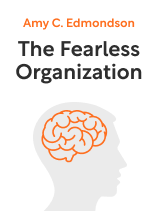

This article is an excerpt from the Shortform book guide to "The Fearless Organization" by Amy C. Edmondson. Shortform has the world's best summaries and analyses of books you should be reading.
Like this article? Sign up for a free trial here.
What is a culture of fear like at work? What are the problems with leading with fear?
In The Fearless Organization, Amy C. Edmondson says that, despite the clear benefits of psychologically safe workplaces, many companies don’t install them. Instead, they continue to take a fear-based tactic that comes with two key problems.
Continue reading to learn the problems with a culture of fear in the workplace.
Problem 1: Fear Leads to Silence, Which Hurts Companies
Edmondson says that in a culture of fear in the workplace, employees don’t speak up out of fear that they, their ideas, and their concerns will be belittled, disregarded, or lead to retaliation. She says that people’s fear of being judged is so great that they engage in a process of “image management” every day, all day long, in which they monitor and censor what they say to avoid looking silly or stupid in front of others. This strategy keeps them safe so long as they say nothing, but once they open their mouths, people can accuse them of being stupid or incompetent again. Most people can’t handle this, so they stay silent to preserve their image.
Edmondson says there are two big problems with employees’ silence at work:
- They become disengaged and demonstrate low levels of creativity and productivity, which hinders organizations’ ability to innovate, grow, and perform.
- They don’t raise red flags that can help their organization ward off preventable problems and crises.
Example: NASA’s Company Culture of Silence Led to Avoidable Disaster
In 2003, NASA engineer Rodney Rocha noticed something troubling on a grainy video of the shuttle Columbia following takeoff. Edmondson writes that when he brought concerns to higher-ups that he believed it was a loose chunk of foam that may have damaged the craft, his manager castigated him for engaging with people above his rank. At a subsequent meeting of senior managers where discussion of the chunk of foam came up, Rocha kept his concerns to himself. Shortly thereafter, the foam caused the shuttle to explode, killing all seven astronauts aboard. When reporters asked Rocha why he didn’t push to let people at NASA know he’d found a potential problem, he responded that he “couldn’t” due to his low ranking.
Edmondson says Rocha’s silence and dilemma are the marks of a psychologically unsafe work climate. Rocha felt unable to speak up, even though doing so could have prevented the catastrophe because his initial attempt earned him a reprimand. Edmondson says this is a common phenomenon in organizations with strict hierarchies, where leaders are siloed from frontline workers who can often provide critical information that would help the companies they work for ward off problems—and prevent them from becoming crises—before they happen.
The consequences of staying silent aren’t just applicable within NASA—they affect any business where frontline staff have access to important on-the-ground information before management. For example, a dairy factory line worker may notice that the ink on milk cartons on the conveyor belt is suddenly smudged and covering the milk’s expiration date. The worker doesn’t report this because their supervisor has previously dressed the worker down for raising concerns and told them only to worry about hitting production targets. As a result, thousands of cartons of milk go to the mass market, people buy and drink milk that’s past its expiration date because the date is smudged, and the company receives thousands of complaints from people who drank sour milk.
Problem 2: Fear Creates an Illusion of Success
Edmondson asserts that fear-driven management approaches are popular and can appear to lead to strong outcomes, but their only true accomplishment is creating the illusion of goals being achieved, while companies rot from the inside out.
Further, although intimidation strategies may have worked more successfully in the past, they’re far less effective in today’s knowledge economy. In the past, companies were able to operate with stricter hierarchies and more rigid goals, and many employees operated in a mode of compliance out of fear that they’d get fired if they didn’t meet the mark. This model is less effective in a complex and uncertain knowledge economy, where organizations’ growth and success depend upon the quality, quantity, and accessibility of information available to them—making employees’ voices and ideas more important than ever. Today’s companies must welcome ideas if they hope to tap into the creativity, innovation, and intel required to thrive.
Edmondson acknowledges that no guarantee replacing a fear-based work culture with a psychologically safe one will result in successful outcomes. To thrive, companies must also have employees with expertise, ingenuity, and the ability to innovate and collaborate effectively. But she maintains that you can’t realize the full potential of these thrive-factors in an environment that’s not psychologically safe. That’s because fear triggers the threat section of your brain, diverting resources away from learning and memory management, thereby limiting your ability to think, collaborate, engage in creative insight, and solve problems.

———End of Preview———
Like what you just read? Read the rest of the world's best book summary and analysis of Amy C. Edmondson's "The Fearless Organization" at Shortform.
Here's what you'll find in our full The Fearless Organization summary:
- The importance of psychological safety in the workplace
- How leaders and non-leaders can foster psychologically safe environments
- Why workers should be able to make mistakes without fear of reprisal






